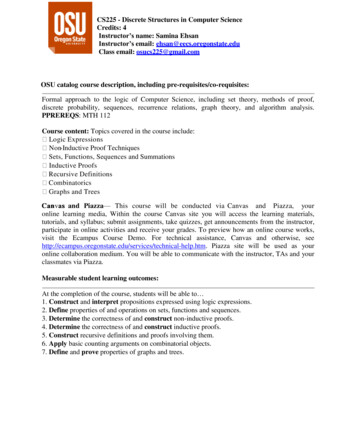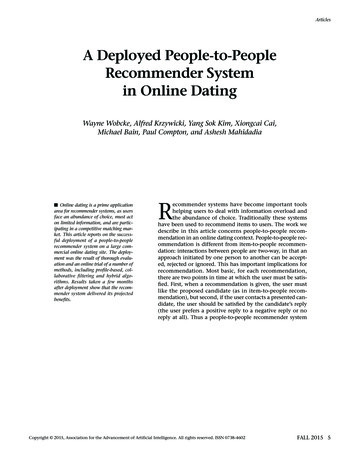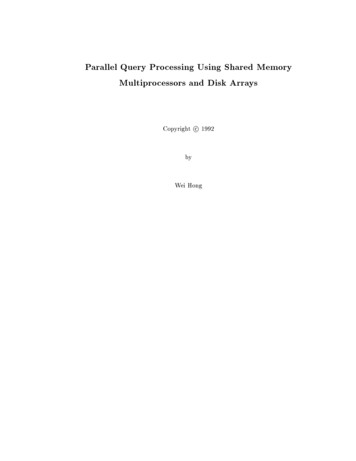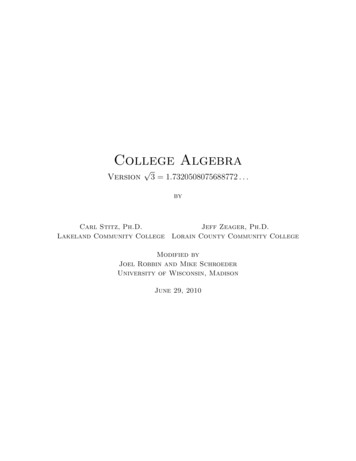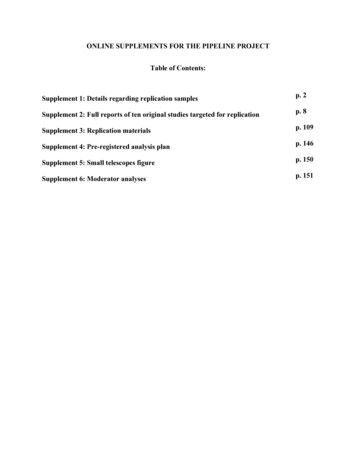
Transcription
Multigrain Shared MemoryyDonald Yeung, zJohn Kubiatowicz, and xAnant Agarwal yUniversity of Maryland at College ParkzUniversity of California at BerkeleyxMassachussetts Institute of TechnologyOctober 6, 2000AbstractParallel workstations, each comprising tens of processors based on shared memory, promisecost-e ective scalable multiprocessing. This paper explores the coupling of such small- tomedium-scale shared memory multiprocessors through software over a local area network tosynthesize larger shared memory systems. We call these systems Distributed Shared-memoryMultiProcessors (DSMPs).This paper introduces the design of a shared memory system that uses multiple granularitiesof sharing, called MGS, and presents a prototype implementation of MGS on the MIT Alewifemultiprocessor. Multigrain shared memory enables the collaboration of hardware and softwareshared memory, thus synthesizing a single transparent shared memory address space across acluster of multiprocessors. The system leverages the e cient support for ne-grain cache-linesharing within multiprocessor nodes as often as possible, and resorts to coarse-grain page-levelsharing across nodes only when absolutely necessary.Using our prototype implementation of MGS, an in-depth study of several shared memoryapplications is conducted to understand the behavior of DSMPs. Our study is the rst tocomprehensively explore the DSMP design space, and to compare the performance of DSMPsagainst all-software and all-hardware DSMs on a single experimental platform. Keeping the totalnumber of processors xed, we show that applications execute up to 85% faster on a DSMPas compared to an all-software DSM. We also show that all-hardware DSMs hold a signi cantperformance advantage over DSMPs on challenging applications, between 159% and 1014%.However, program transformations to improve data locality for these applications allow DSMPsto almost match the performance of an all-hardware multiprocessor of the same size.This research was funded in part by DARPA contract N00014-94-1-0985 and in part by NSF ExperimentalSystems grant MIP-9504399. Copyright 2000 by the Association for Computing Machinery, Inc. Permission to makedigital or hard copies of part or all of this work for personal or classroom use is granted without fee provided thatcopies are not made or distributed for pro t or commercial advantage and that copies bear this notice and the fullcitation on the rst page. Copyrights for components of this work owned by others than ACM must be honored.Abstracting with credit is permitted. To copy otherwise, to republish, to post on servers, or to redistribute to lists,requires prior speci c permission and/or a fee. Request permissions from Publications Dept, ACM Inc., fax 1 (212)869-0481, or permissions@acm.org. 1
1 IntroductionLarge-scale shared memory multiprocessors have received signi cant attention within the computerarchitecture community over the past decade, in large part due to two factors. First, the sharedmemory programming model is desirable because it relieves the programmer from the burdenof explicitly orchestrating communication, as is required by a message passing communicationmodel 1]. Second, large-scale shared memory machines have the potential for extremely goodcost-performance. They are constructed using nodes that rely only on modest technology. Unliketraditional supercomputers, large-scale shared memory machines use commodity microprocessors,and achieve high performance by exploiting medium- to coarse-grain parallelism across a largenumber of nodes.While the promise for cost-performance has contributed to the popularity of large-scale sharedmemory machines, this promise has thus far gone unful lled due to the high cost of providinge cient communication mechanisms at large scales. Traditionally, large-scale shared memory machines support e cient communication through aggressive architectural support. An example is thehardware cache-coherent distributed shared memory (DSM) architecture. Hardware DSMs are builtusing custom communication interfaces, high performance VLSI interconnect, and special-purposehardware support for shared memory. These aggressive architectural features provide extremely ef cient communication between nodes through tightly coupled hardware interfaces. Although suche cient communication is crucial for scalable performance on communication-intensive applications, the investment in hardware mechanisms comes at a cost. Tight coupling between nodes isdi cult to maintain in a cost-e ective manner as the number of nodes becomes large. Fundamentalobstacles prevent large tightly-coupled systems from being cost e ective. The cost of power distribution, clock distribution, cooling, and special packaging considerations in tightly coupled systemsdo not scale linearly with size. Perhaps most important, the large-scale nature of these machinesprevents them from capitalizing on the economy of cost that higher volume small-scale machinesenjoy.In response to the high design cost of large-scale hardware DSMs, many researchers have proposed building large-scale shared memory systems using commodity uniprocessor workstations asthe compute node building block. In these lower cost systems, the tightly coupled communicationsinterfaces found in hardware DSMs are replaced by commodity interfaces. Furthermore, commodity networks such as those found in the local area environment are used to connect the workstationnodes, and the shared memory communication abstraction is supported purely in software. Suchsoftware DSM architectures are cost e ective because all the components are high volume commodity items and because specialized tightly-coupled packaging is not required. Unfortunately,software DSMs are unable to provide high performance across a wide range of applications 2].While communication interfaces for commodity workstations have made impressive improvements,the best reported inter-workstation latency numbers are still an order of magnitude higher than onmachines that have tightly-coupled special-purpose interfaces 3]. The high cost of communicationon commodity systems prevents them from supporting applications with intensive communicationrequirements.Traditional architectures for large-scale shared memory machines have not satisfactorily addressed the tension between providing e cient communication mechanisms for high performanceand leveraging commodity components for low cost. In this paper, we explore a new approach tobuilding large-scale shared memory machines that leverages small- to medium-scale shared mem2
ory multiprocessors as the building block for larger systems. Small-scale (2{16 processor) andmedium-scale (17{128 processor) shared memory machines are commodity components. A familiarexample is the bus-based symmetric multiprocessor. Another example is the small- to medium-scaledistributed-memory multiprocessor. The latter architecturally resembles large-scale (greater than128 processor) tightly-coupled machines, but is targeted for smaller systems. Since both symmetricmultiprocessors and small- to medium-scale distributed-memory multiprocessors are relevant to ourwork, we will refer to both of them using the single term, SMP.1The SMP is an attractive building block for large-scale multiprocessors for two reasons. First,SMPs provide e cient hardware support for shared memory. A larger system that can leverage thise cient hardware support has the potential for higher performance than a network of conventionaluniprocessor workstations in which shared memory is implemented purely in software. And second,the e cient shared memory mechanisms provided by SMPs do not incur exorbitant costs becausethe tight coupling required is only provided across a small number of processors. Unlike largescale hardware DSMs, SMPs can be cost-e ective as evidenced by the commercial success of thebus-based symmetric multiprocessor.We call a large-scale system built from a collection of SMPs a Distributed Shared memoryMultiProcessor (DSMP). DSMPs are constructed by extending the hardware-supported sharedmemory in each SMP using software DSM techniques to form a single shared memory layer acrossmultiple SMP nodes. Such hybrid hardware-software systems support shared memory using twogranularities, hence the name Multigrain Shared Memory. Cache-coherent shared memory hardwareprovides a small cache-line sharing grain between processors colocated on the same SMP. Pagebased software DSM provides a larger page sharing grain between processors in separate SMPs.Recently, several DSMP architectures have been constructed and studied 6, 7, 8, 9, 4]. Thispaper builds upon the work in 4] and makes the following novel contributions:1. We present a fully functional design of a multigrain shared memory system, called MGS, andprovide a prototype implementation of MGS on the Alewife multiprocessor.2. We de ne two performance metrics, the breakup penalty and the multigrain potential, thatcharacterize application performance on DSMPs.3. We provide a performance evaluation of several shared memory programs on the MGS prototype. While other performance evaluations of DSMP systems have been conducted (seeSection 6), our study is the rst to explore the entire spectrum of DSMP architectures andto provide a consistent comparison of these architectures against traditional all-software andall-hardware DSMs on a single experimental platform.4. We quantify the impact of program transformations for data locality to more e ectivelyleverage the clustered nature of DSMPs.Traditionally, only symmetric multiprocessors have been called SMPs. In 4], which describes the original versionof this work, we introduced the terminology SSMP (for Scalable Shared memory MultiProcessor) as a general termto describe both bus-based and switched-interconnect architectures. However, in recent SMP machines, the trendhas been to replace the shared bus with a switched interconnect 5] thus blurring the distinction between traditionalSMPs and distributed-memory machines. Since manufacturers have called these new systems SMPs as well (thusmaking our original terminology a misnomer), we adopt the familiar SMP terminology for both bus-based andswitched-interconnect architectures throughout the rest of this paper.13
The rest of this paper is organized as follows. Section 2 describes the DSMP architecture andmultigrain shared memory, and presents our performance metrics for DSMPs. Section 3 presents theMGS design, and section 4 discusses our prototype implementation of MGS on Alewife. Section 5presents the experimental results, and Section 6 discusses related work. Finally, Section 7 presentsour conclusions.2 Multigrain Shared MemoryIn this section, we describe a DSM architecture that supports shared memory in a multigrainfashion, called a DSMP. We also describe what we call DSMP families, and present a performanceframework that allows us to reason about the performance of applications on DSMPs based on thenotion of DSMP families.2.1 DSMPsTraditional all-hardware and all-software DSMs implement shared memory in a monolithic fashion.All-hardware systems support shared memory entirely in hardware using special-purpose interfacesleading to high-performance at the expense of high cost. All-software systems support sharedmemory entirely in software using commodity interfaces leading to low-cost at the expense of poorperformance on communication-intensive applications. Due to their monolithic nature, these traditional architectures are positioned at two extremes across a wide spectrum of cost and performance.Unfortunately, the ability to trade o cost for performance along this spectrum does not currentlyexist for large-scale shared memory machines.We propose an \intermediate architecture" between all-hardware and all-software DSMs, calledDistributed Shared memory MultiProcessors (DSMPs). DSMPs provide some tight coupling, butnot across the entire machine. \Neighborhoods" of tight coupling are formed using cache-coherentshared memory within small- to medium-scale multiprocessor nodes. Shared memory betweencache-coherent nodes is supported via page-based software DSM techniques. Therefore, a singletransparent shared memory layer is synthesized through the cooperation of both ne-grain andcoarse-grain shared memory mechanisms, hence the name multigrain shared memory.Figure 1 shows the major components in a DSMP. A DSMP is a distributed shared memorymachine in which each DSM node is itself a multiprocessor. These nodes are small- to medium-scalecache-coherent shared memory machines. We envision that each node will either be a bus-basedsymmetric multiprocessor (such as the SGI Challenge), or a small- to medium-scale distributedmemory (NUMA) multiprocessor (such as the SGI Origin 10] in a small-scale con guration).Throughout this paper, we will refer to both types of node architectures using the same terminology, SMP.As Figure 1 shows, DSMPs have two types of networks that form the communication substrate:an internal network and an external network. The internal network provides interconnection between processors within each SMP. In the case that the SMP is a symmetric multiprocessor, thisnetwork is a bus. In the case that the SMP is a NUMA multiprocessor, it may be a switchedpoint-to-point network. The external network connects the individual SMPs and consists of ahigh-performance local area network (LAN), such as ATM or switched Ethernet.In addition to a hierarchy of networks, DSMPs also provide shared memory support in a hier4
SMPSMPPPPPPPCCCCCCInternal NetworkInternal NetworkExternal NetworkFigure 1: A Distributed Shared memory MultiProcessor (DSMP).archical fashion. Each SMP provides special-purpose hardware for cache-coherent shared memory.This may take the form of snoopy-based cache coherence in the case of bus-based machines, ordirectory-based cache coherence in the case of NUMA multiprocessors. Between SMPs, sharedmemory is supported using page-based software shared memory.DSMPs have the potential to achieve both high performance and low cost. The existence ofhardware support allows ne-grain sharing to be supported e ciently inside a multiprocessor node.Although only coarse-grain sharing can be supported by the software shared memory betweennodes, multigrain systems still o er higher performance on ne-grain applications than softwareDSMs since some ne-grain mechanisms are provided. In addition, multigrain systems are alsomuch more cost-e ective than hardware DSMs. Even though they require hardware support forshared memory, multigrain systems incorporate hardware support only on a small- or medium-scale.2.2 DSMP FamiliesA key parameter that describes any parallel machine is the system size, or the number of processingelements in the system, . DSMPs can also be characterized in this fashion however, another keyparameter in the case of DSMPs is the SMP node size, . Therefore, the two parameters, and, identify speci c DSMP con gurations.Many DSMP con gurations are similar in particular, we say that all con gurations with thesame parameter belong to the same DSMP family. As illustrated in Figure 2, a family of DSMPsis de ned by xing the total number of processing elements, , and varying SMP node size.2 DSMPsin the same family di er only in the way processors are clustered. The clustering boundary, i.e.the boundary that divides processors on the same SMP from those that are on remote SMPS,determines where hardware-supported shared memory meets software-supported shared memory.Therefore, by varying SMP node size, we in e ect vary the mix of ne-grain and coarse-grain supportPCPCPP2In this paper, we only consider SMP node sizes, C , that divide P evenly. Otherwise, the DSMP will containSMPs of varying sizes, in which case a single SMP node size parameter cannot specify the sizes of all SMPs in thesystem.5
P,4P,8P,21PFigure 2: A family of DSMPs is de ned by xing the total processing and memory resources, andvarying the SMP node size. The two parameters, and , denote a DSMP with total processors,and processors per SMP node.PCPCfor sharing between processors. DSMPs with smaller SMP nodes rely more on software-supportedshared memory and provide more coarse-grain (page granularity) sharing support. Conversely,DSMPs with larger SMP nodes rely more on hardware-supported shared memory and providemore ne-grain (cache-line granularity) sharing support. Furthermore, monolithic shared memorymachines are degenerate con gurations: all-software DSMs have 1 (e.g. 1), and all-hardwareDSMs have (e.g.).The most important aspect of theparameters is that they point to the existence of a\knob," as depicted in Figure 2. This knob is not only an SMP node size knob and a sharinggranularity knob, but it also serves as a knob for tuning cost against performance.CCPP P PP C2.3 DSMP Performance FrameworkA performance framework that characterizes application performance on DSMPs can be de nedbased on the notion of DSMP families and the node size knob. Given a DSMP with a xed totalmachine size , we measure an application's performance on the DSMP as the SMP node size isvaried from 1 to . This set of measurements constitutes the application's performance pro le. Theperformance pro le tells us how an application responds to a change in the mixture of hardwareand software in the implementation of shared memory. It re ects the degree of ne-grain hardwaremechanisms needed relative to coarse-grain software mechanisms for the application to achieve acertain level of performance. Furthermore, since the endpoints of the performance pro le, 1and , correspond to the all-software and all-hardware DSMs, respectively, the performancepro le also compares DSMP performance to the performance achieved on monolithic (conventional)shared memory machines.PCPCCP6
Execution TimeExecution enalty124BreakupPenaltyP/2 PNode Size1Figure 3: A hypothetical application24P/2 PNode SizeFigure 4: A hypothetical application an-analyzed using the performance framework. This application is not well-suitedfor DSMPs.alyzed using the performance framework.This application is well-suited for DSMPs.Figure 3 shows the performance pro le of a hypothetical application. Execution time is plottedagainst the SMP node size parameter, , in powers of 2 for a total system size, . We de ne twoquantitative metrics that identify the most important features on the performance pro le. Thesemetrics have been labeled in Figure 3, and are:CPBreakup Penalty. The execution time increase between the SMP node size and the P2 SMPPnode size is called the \breakup penalty." The breakup penalty measures the minimumperformance penalty incurred by breaking a tightly-coupled (all-hardware shared memory)machine into a clustered machine.Multigrain Potential. The di erence in execution time between an SMP node size of 1 and anSMP node size of P2 is called the \multigrain potential." The multigrain potential measuresthe performance bene t derived by capturing ne-grain sharing within SMP nodes.Our performance framework tells us that the hypothetical application in Figure 3 is not wellsuited for DSMPs. First, the application's performance pro le has a large breakup penalty. Thisindicates that the application will perform poorly on the DSMP as compared to an all-hardwarecache-coherent DSM. Second, the multigrain potential is small indicating that very little bene t isderived from the hardware-supported shared memory provided within SMP nodes therefore, thisapplication will not achieve much higher performance on a DSMP as compared to an all-softwareDSM.In contrast, Figure 4 shows the analysis of another hypothetical application, again using ourperformance framework. The performance pro le presented in Figure 4 displays a very smallbreakup penalty. This application will perform almost as well on a DSMP as it will on an allhardware system becaus
Multigrain Shared Memory y Donald Y eung z John Kubiato wicz and x Anan t Agarw al y Univ ersit y of Maryland at Colleg

